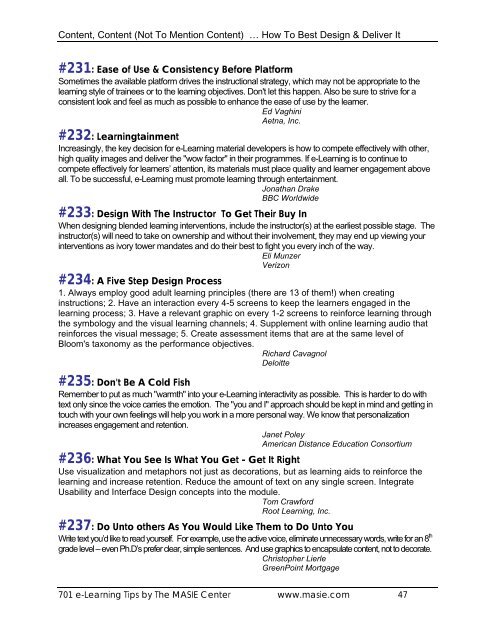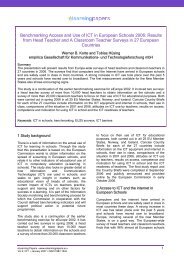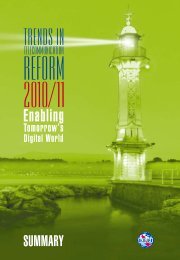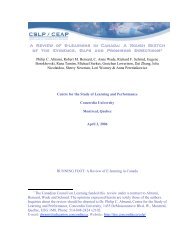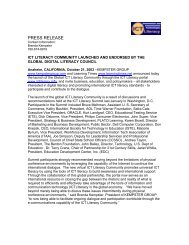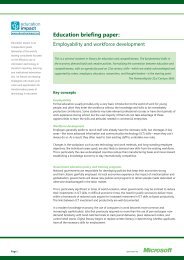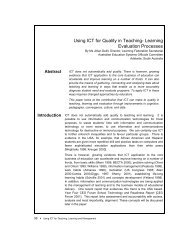147 pages pdf - ICT Digital Literacy
147 pages pdf - ICT Digital Literacy
147 pages pdf - ICT Digital Literacy
You also want an ePaper? Increase the reach of your titles
YUMPU automatically turns print PDFs into web optimized ePapers that Google loves.
Content, Content (Not To Mention Content) … How To Best Design & Deliver It<br />
#231: Ease of Use & Consistency Before Platform<br />
Sometimes the available platform drives the instructional strategy, which may not be appropriate to the<br />
learning style of trainees or to the learning objectives. Don't let this happen. Also be sure to strive for a<br />
consistent look and feel as much as possible to enhance the ease of use by the learner.<br />
Ed Vaghini<br />
Aetna, Inc.<br />
#232: Learningtainment<br />
Increasingly, the key decision for e-Learning material developers is how to compete effectively with other,<br />
high quality images and deliver the "wow factor" in their programmes. If e-Learning is to continue to<br />
compete effectively for learners’ attention, its materials must place quality and learner engagement above<br />
all. To be successful, e-Learning must promote learning through entertainment.<br />
Jonathan Drake<br />
BBC Worldwide<br />
#233: Design With The Instructor To Get Their Buy In<br />
When designing blended learning interventions, include the instructor(s) at the earliest possible stage. The<br />
instructor(s) will need to take on ownership and without their involvement, they may end up viewing your<br />
interventions as ivory tower mandates and do their best to fight you every inch of the way.<br />
Eli Munzer<br />
Verizon<br />
#234: A Five Step Design Process<br />
1. Always employ good adult learning principles (there are 13 of them!) when creating<br />
instructions; 2. Have an interaction every 4-5 screens to keep the learners engaged in the<br />
learning process; 3. Have a relevant graphic on every 1-2 screens to reinforce learning through<br />
the symbology and the visual learning channels; 4. Supplement with online learning audio that<br />
reinforces the visual message; 5. Create assessment items that are at the same level of<br />
Bloom's taxonomy as the performance objectives.<br />
Richard Cavagnol<br />
Deloitte<br />
#235: Don't Be A Cold Fish<br />
Remember to put as much "warmth" into your e-Learning interactivity as possible. This is harder to do with<br />
text only since the voice carries the emotion. The "you and I" approach should be kept in mind and getting in<br />
touch with your own feelings will help you work in a more personal way. We know that personalization<br />
increases engagement and retention.<br />
Janet Poley<br />
American Distance Education Consortium<br />
#236: What You See Is What You Get - Get It Right<br />
Use visualization and metaphors not just as decorations, but as learning aids to reinforce the<br />
learning and increase retention. Reduce the amount of text on any single screen. Integrate<br />
Usability and Interface Design concepts into the module.<br />
Tom Crawford<br />
Root Learning, Inc.<br />
#237: Do Unto others As You Would Like Them to Do Unto You<br />
Write text you’d like to read yourself. For example, use the active voice, eliminate unnecessary words, write for an 8 th<br />
grade level – even Ph.D’s prefer clear, simple sentences. And use graphics to encapsulate content, not to decorate.<br />
Christopher Lierle<br />
GreenPoint Mortgage<br />
701 e-Learning Tips by The MASIE Center www.masie.com 47


